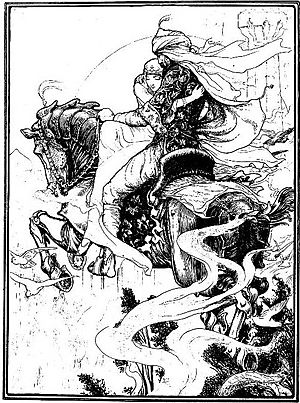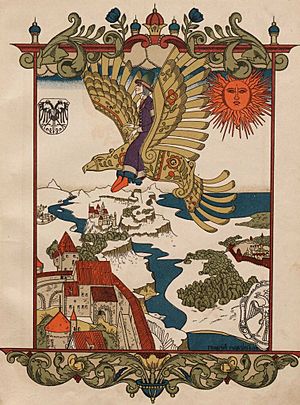The Ebony Horse facts for kids
Quick facts for kids The Ebony Horse |
|
|---|---|

The Prince flies with the princess on the mechanical horse. Illustration by John D. Batten.
|
|
| Folk tale | |
| Name | The Ebony Horse |
| Also known as | The Enchanted Horse |
| Data | |
| Aarne–Thompson grouping | ATU 575 (The Prince's Wings) |
| Published in | One Thousand and One Nights |
| Related | The Wooden Eagle (ru) |
The Ebony Horse, also known as the Enchanted Horse or Magic Horse, is a famous folk tale from the collection of stories called The Arabian Nights. This exciting story features a special mechanical horse that can fly! It's controlled by keys and can travel incredibly fast, even into space. The horse helps the Prince of Persia, Qamar al-Aqmar, on amazing adventures across lands like Persia, Arabia, and Byzantium.
Contents
Where Did the Story Come From?
The story of "The Ebony Horse" was first shared by a man named Hanna Diyab. He was a Christian Maronite who told many tales to a French writer, Antoine Galland. Galland wrote down the story in his diary on May 13, 1709.
What Happens in the Story?
The Amazing Mechanical Horse
In the city of Schiraz, Persia, during a New Year's party, a man from India arrives. He brings a fantastic horse that looks real but is actually a machine! The king is very impressed and decides to give this amazing creation to his son, the prince.
The Prince's First Flight
The young prince quickly climbs onto the mechanical horse. He starts to fly higher and higher. Soon, he can't figure out how to make the horse land. He flies away to unknown places!
Love in Bengal
Later, the prince rides the flying horse to the kingdom of Bengal. There, he meets a beautiful princess. They quickly fall in love, sharing sweet words and dreams. The Persian prince convinces the princess to fly with him back to his home in Persia on the mechanical horse.
A Tricky Turn of Events
Meanwhile, the Indian inventor of the horse had been put in jail. This happened because the prince's first flight went wrong. From his cell, the inventor sees the prince return with the princess. The King of Persia lets the inventor out. But the inventor wants revenge! He quickly takes the horse with the princess still on it and flies away.
The Princess in Cashmere
The inventor and the princess land in the Kingdom of Cashmere. The king of Cashmere rescues the princess from the inventor. He then decides he wants to marry her.
The Prince's Plan
The Persian prince is very sad about losing his beloved princess. He wanders until he reaches Cashmere. There, he learns that his princess is alive! He then creates a clever plan to escape with her on the mechanical horse and return to Persia.
How the Story Influenced Others
This tale traveled to Europe and inspired many similar stories from the Middle Ages. These stories also featured amazing mechanical horses. Some famous examples include Cleomades, The Squire's Tale by Chaucer, Valentine and Orson, and Meliacin ou le Cheval de Fust. The last one was written by a troubadour named Girart d'Amiens.
Other Versions of the Story
The idea of a prince traveling on a mechanical flying machine appears in many stories, especially from Eastern cultures.
European Versions
- In a Romani language story called The Flying Hero, a skilled craftsman makes a pair of wings. He uses them to fly to a "Ninth Region" and sells them to a prince. The prince then flies to another land and learns about a princess locked in a tower.
- The Brothers Grimm also had a German version called Of The Carpenter and The Turner. It was in their first book in 1812 but was later removed.
- Another German story is The Flying Trunk, where a man's flying box takes him to a princess's tower. He pretends to be the Son of God to trick her.
- In Hungary, the tale The Winged Prince tells of a king who traps his daughter. But a prince visits her every night using a pair of wings.
- A Russian version is known as "Деревянный орёл" (The Wooden Eagle). In this story, a wooden eagle is the flying creation.
Middle Eastern Versions
- A similar story called The Tale of the Ebony Horse is also found in One Hundred and One Nights, another collection of Arab stories.
- In Story of the Labourer and the Flying Chair, a poor worker buys an old chair that can fly. He uses it to visit a sleeping princess and pretends to be Azrael, the Angel of Death.
- Another tale, Story of Malek and the Princess Schirine, features a hero named Malek. He gets a bird-shaped box from an artisan. He flies in the box to a distant kingdom where a princess is locked in a tower.
South Asian Versions
- An Indian story called The Magic Horse is very similar.
- In Prince Ahmed and the Flying Horse, Prince Ahmed's friends create amazing things. One friend makes a wooden horse that Prince Ahmed rides to a new land. He falls in love with a princess and brings her home.
- The Wax Horse tells of a prince who buys a wax horse with wings. He flies away on it and meets a princess.
- In Concerning a Royal Prince and a Princess, a carpenter's son makes a Wooden Peacock. A prince flies it to another kingdom and meets a princess.
Modern Story Versions
- Illustrator Howard Pyle wrote The Stool of Fortune. In this story, a soldier sits on a magic three-legged stool that flies him to a princess's room. He calls himself "The King of Winds."
- Sufi scholar Idries Shah wrote a children's book called The Magic Horse. In his version, a woodcarver builds a wooden horse that catches the eye of Prince Tambal.
Movies and Shows Inspired by the Story
- The Russian version, "The Wooden Eagle," was made into a Soviet animated film in 1953.
- The story was also adapted into a Czech fantasy film in 1987. It was called Princess Jasnenka and the Flying Shoemaker. This movie was based on a fairy tale by Czech author Jan Drda.


